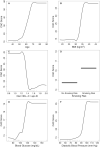Risk Factor Interactions, Non-High-Density Lipoprotein Cholesterol to Apolipoprotein B Ratio, and Severity of Coronary Arteriosclerosis in South Asian Individuals: An Observational Cohort Study
- PMID: 37183833
- PMCID: PMC10227306
- DOI: 10.1161/JAHA.122.027697
Risk Factor Interactions, Non-High-Density Lipoprotein Cholesterol to Apolipoprotein B Ratio, and Severity of Coronary Arteriosclerosis in South Asian Individuals: An Observational Cohort Study
Abstract
Background South Asian individuals are at higher risk for arteriosclerotic cardiovascular disease and diabetes. The factors associated with arteriosclerotic cardiovascular disease severity and their interactions are unknown. Methods and Results This is a retrospective cohort study of the first 1162 South Asian participants enrolled in the South Asian Heart Center's AIM to Prevent Program who completed noncontrast coronary computed tomography scans. Using machine-learning algorithms, we identified and modeled the interaction of predictor variables with coronary artery calcification (CAC) severity in South Asian individuals. Anthropometric, laboratory, demographic, and lifestyle predictor variables were analyzed using continuous boosted regression trees to model the relationship with and in between predictor variables and CAC. Participants with CAC were older, predominately men, had smoking history, had personal histories of diabetes, hypertension, and hypercholesterolemia, and had family histories of coronary artery disease. Insulin, body mass index, blood pressure, fasting blood sugar, hemoglobin A1c, and waist-to-height ratio were associated with CAC but not low-density lipoprotein cholesterol or lipoprotein (a). The arteriosclerotic cardiovascular disease score failed to classify individuals. Only age, body mass index, non-high-density lipoprotein cholesterol/apolipoprotein B ratio, smoking risk, fasting blood sugar, and diastolic blood pressure were predictive, explaining 30.3% of CAC severity. A non-high-density lipoprotein cholesterol/apolipoprotein B ratio of 1.4 or less markedly increased coronary calcification. Conclusions Our findings highlight factors associated with dysmetabolism and cholesterol-depleted non-high-density lipoprotein cholesterol particles with coronary arteriosclerosis, possibly explaining the dual epidemics of diabetes and arteriosclerotic cardiovascular disease in this population. Markers of glucose dysmetabolism and the non-high-density lipoprotein cholesterol to apolipoprotein B ratio should become the focus of assessment for cardiovascular risk in South Asian individuals, with prevention strategies directed at improving glucose metabolic health.
Keywords: apolipoprotein B; coronary artery calcification; coronary artery disease; diabetes mellitus; dyslipidemia; dysmetabolism; non–HDL‐C to apoB ratio.
Figures


References
-
- Yusuf S, Hawken S, Ôunpuu S, Dans T, Avezum A, Lanas F, McQueen M, Budaj A, Pais P, Varigos J. Effect of potentially modifiable risk factors associated with myocardial infarction in 52 countries (the INTERHEART study): case‐control study. Lancet. 2004;364:937–952. doi: 10.1016/S0140-6736(04)17018-9 - DOI - PubMed
Publication types
MeSH terms
Substances
LinkOut - more resources
Full Text Sources
Medical
Miscellaneous

